The 9th Dawlish Chronicle is now available – details at end of article
Discipline, heroism and survival:
HMS Alceste, 1817
The aftermath of the wreck of the French frigate Medusa in 1816 is widely regarded as one of the most horrible events in maritime history. Abandoned on an overloaded raft by officers and crew who took to the boats when the vessel grounded off the coast of modern Mauritania, only fifteen persons survived out of a total of 147. In the thirteen days the raft drifted, 132 died through thirst and starvation, fighting and suicide. Cannibalism sustained the survivors. Though the ship’s boats had reached safety no systematic search was made for the raft and it was only discovered, accidentally, by the British ship Argus. A major scandal at the time, the raft became the subject of an unforgettable painting by Théodore Géricault (1791-1824).
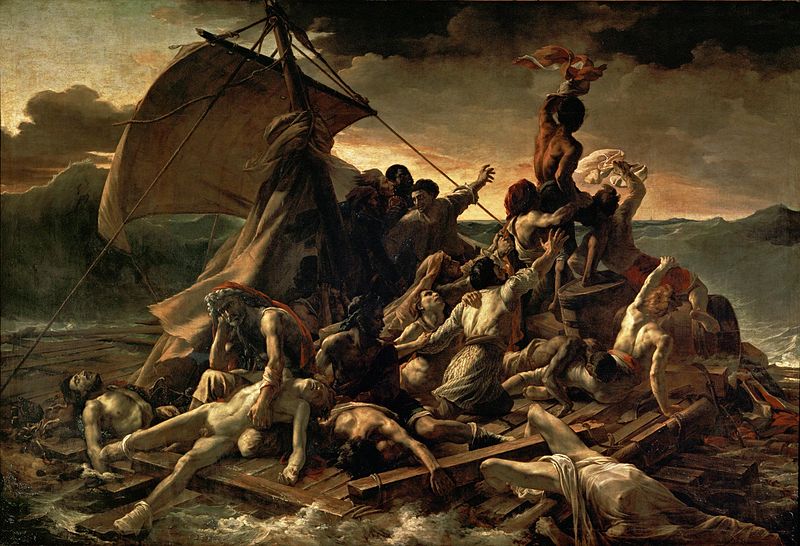
“The Raft of the Medusa” – today in the Louvre, Paris
The breakdown in responsibility and discipline that led to this appalling disaster can be contrasted with the happy outcome of what could have been a similar tragedy when a Royal Navy frigate, HMS Alceste, was wrecked the following year. The value of professionalism and discipline has seldom been so dramatically illustrated.
HMS Alceste was built in 1804, as the Minerve, for the French Navy – generally similar in fact to the Medusa. Two years later she was captured by the Royal Navy and taken into service as HMS Alceste, under command of Captain (afterwards Sir) Murray Maxwell, (1775 –1831). He was to be her captain for much of her Royal Navy career until her final loss. In 1811, in company with HMS Active, Maxwell and the Alceste captured the French frigate Pomome. Maxwell was to be congratulated on this in strange and unforeseeable circumstances six years later. HMSAlceste provided sterling service through the remainder of the Napoleonic Wars and in the War of 1812.
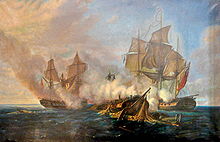
The capture of the French frigate Pomone by HMS Alceste and HMS Active
Painting by Pierre Julien Gilbert (1783-1860)
In 1816 HMS Alceste was assigned to carrying William Pitt Amehurst, the first Lord Amherst, on a diplomatic mission to China, the objective being to establish formal relations between Britain and the Chinese Empire. Amehurst was landed at Canton (Guangzhou) and travelled overland to Pekin (Beijing). In his absence Captain Maxwell and HMS Alceste undertook extensive survey work in uncharted waters off the coasts of China, Korea, and Okinawa. This work is so well thought of, even today, that Maxwell has been honoured by a South Korean postage stamp.

Sir Murray Maxwell – the only Royal Navy officer honoured by a Korean stamp?
On her return to China HMS Alceste required repairs to ready her for the long voyage home. This necessitated mooring in calm water in the Pearl River, close to Canton. A request to do so was refused by the Chinese authorities, who threatened to have the gun-batteries guarding the river open on HMS Alceste should she proceed. Captain Maxwell responded in the robust manner to be expected of the Royal Navy of his day – he bombarded and subdued the shore defences and some seventeen war-junks supporting them. He then moored, commenced his repairs and awaited Amehurst’s return.
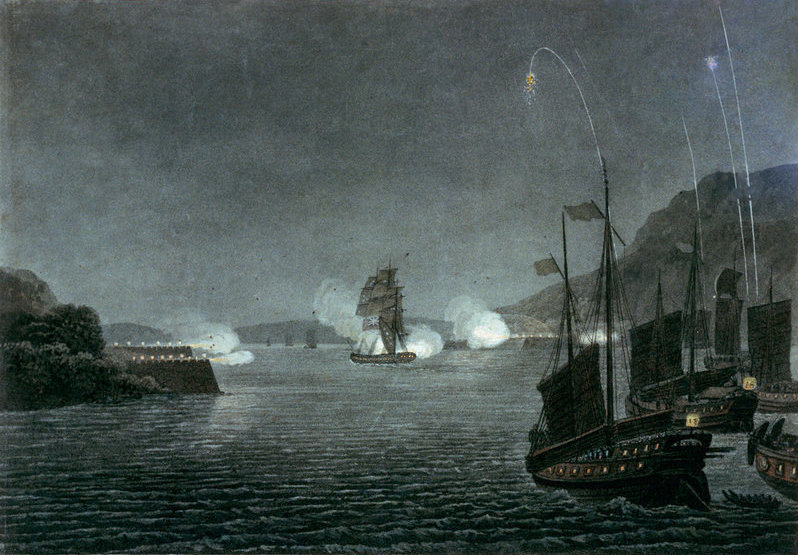
HMS Alceste attacking the Chinese batteries and junks. Note Chinese rockets
As depicted by Alceste’s surgeon, John MacLeod, in his account of her final voyage
In the event Amehurst’s mission proved to be a total failure, doomed as it was by mutual incomprehension. Self-sufficient for millennia, China officials had little or no understanding of the outside world and regarded all other nations as inferior. Amehurst was informed that he could only be admitted to the Emperor’s presence if he were to kowtow – which meant kneeling and bowing so low as to touching the forehead on the ground. As representative of a proud nation that had opposed the might of France and her allies for over twenty years, and which had the previous year seen off the Emperor Napoleon, Amehurst had no intention of abasing himself or his country. Faced with an impasse, he had no option to head home. He rejoined HMS Alceste and she set out for England, he and his entourage, plus the frigates crew, adding up to 257 on board.
Disaster struck in the Java Sea – an area largely uncharted at the time. Despite continuous soundings HMS Alceste ran on to a hidden reef on 18 February 1817, the damage so severe that the flooding was too much for the pumps to handle. Abandonment was now essential, the nearest island, Pulau Liat, being close enough for crew and passengers to be transferred safely to shore. In an uncanny resemblance to the Medusa wreck, a raft was used in the evacuation in addition to the ship’s boats. On this occasion however order and discipline prevailed. Provisions and fresh water were at a premium however and it was decided that the boats would head for Batavia (now Djakarta), the Dutch administrative centre in Java, 200 miles to the south, to organise a rescue. Amehurst joined them.
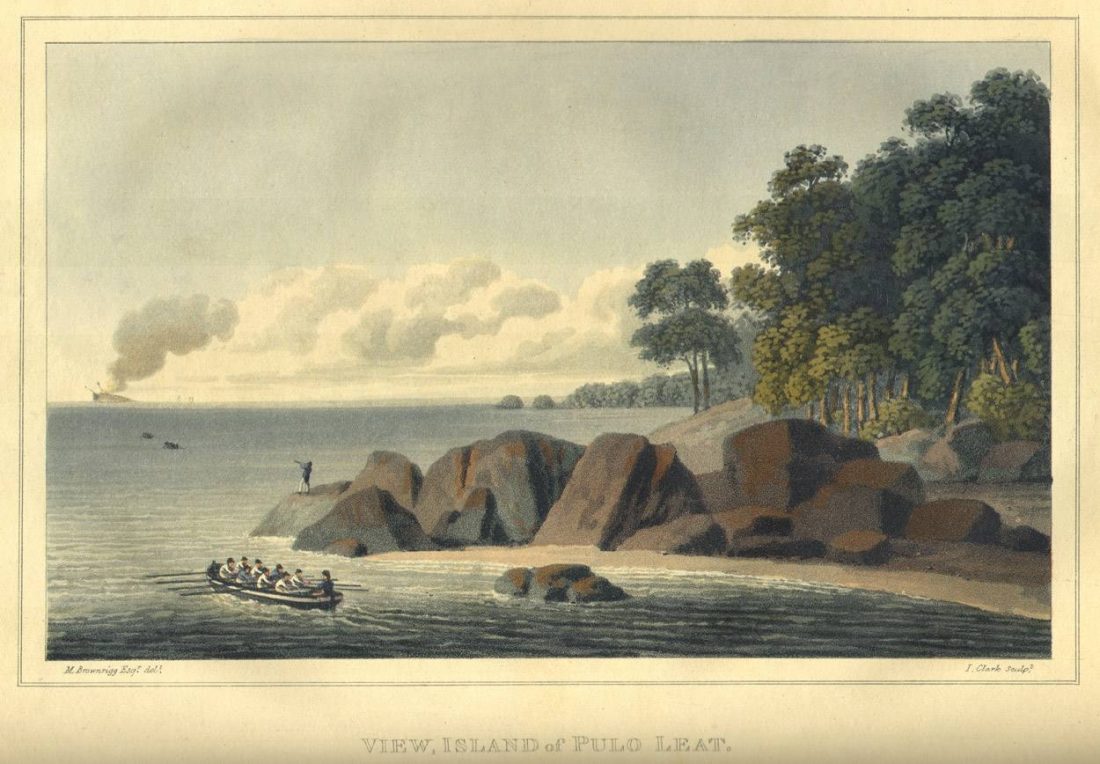
Boats setting out from the island to salvage what remains on the burning hulk
Engraving from one of Surgeon Macleod’s illustrations
Captain Maxwell had remained on the island and now organised a return to the wreck to recover whatever supplies remained as there were still some 200 mouths to feed. The attempt was interrupted by the arrival of Malay pirates and the salvage party, which had been unarmed, had to beat a hasty retreat. The pirates looted the wreck and burned it thereafter. Fearing further pirate attack, Maxwell supervised construction of a stockade – called appropriately “Camp Maxwell” – and readied it for defence. Another salvage party managed to recover some flour and wine from the Alceste’s burned-out hulk but the supplies-situation remained critical.
The anticipated pirate attack came on 26 February. A sortie led by Alceste’s second lieutenant led to an initial repulse – with several pirates killed – but further pirate reinforcements arrived thereafter. They made no attempt to land, contenting themselves with firing swivel guns towards the stockade. Yet more pirates arrived and on 1 March an assault, which promised to be overwhelming, seemed imminent. It was at this critical juncture that a ship was seen approaching. Her appearance, and a brief attack by Alceste’s marines, broke the pirates’ resolve and they fled. The vessel turned out to be an East-Indiaman, the Ternate, which Amehurst had encountered in Batavia. It was to here she returned the castaways – not a single life had been lost – and Amehurst chartered another ship, the Caesar, to take them back to Britain.
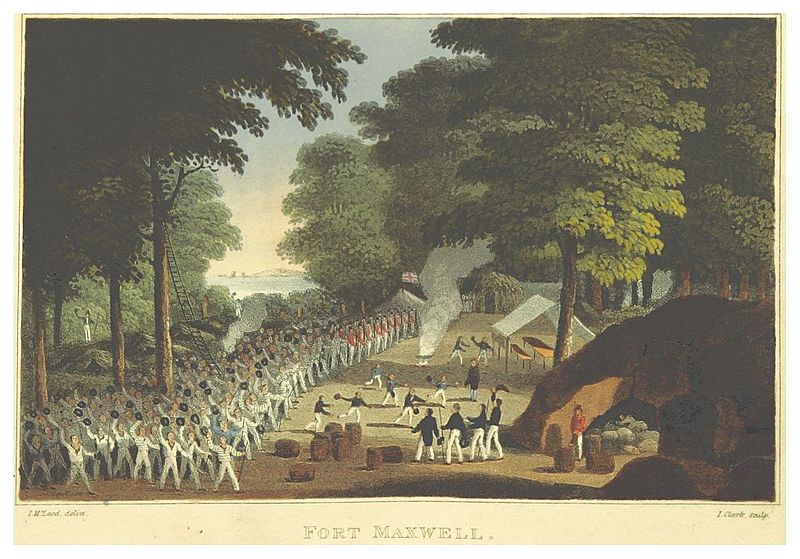
Camp Maxwell – the passengers and crew of HMS Alceste cheer their rescuers
An engraving from one of Surgeon MacLeod’s illustrations
The Caesar put in to St. Helena on her voyage home and both Amehurst and Maxwell had an audience with the ex-Emperor Napoleon, now in his second year of exile there. Napoleon complimented Maxwell on his achievement and hoped that he would be exonerated (as he was to be) in the inevitable court-martial for her loss. He also referred admiringly – and sportingly – to Maxwell’s capture of the French Pomone in 1811. It was to Amehurst, when discussing his failed mission, that Napoleon made his celebrated remark “China is a sleeping giant. Let her sleep. For when she wakes, she will shake the world” – a prophesy which has to come to pass in our own day.
Maxwell was rightly hailed as a hero, was knighted in 1818. He was however seriously injured by a paving stone thrown from a mob opposing him when he stood for Parliament that same year. He returned to naval service and held a number of responsible positions but he never recovered from the paving stone injury. He died at 56 – too young. Amherst was to serve as Governor-General of India from 1823 to 1828.
And now, when we admire Géricault’s “Raft of the Medusa” we should remember the Alceste also. She and her gallant crew deserve it.
The latest – 9th – volume of the Dawlish Chronicles is now available
Britannia’s Morass
September – December 1884
 I’m pleased to announce that Britannia’s Morass was published in both Paperback and Kindle formats on 12th December 2020.
I’m pleased to announce that Britannia’s Morass was published in both Paperback and Kindle formats on 12th December 2020.
Click on https://amzn.to/39oTAWx for the US and on https://amzn.to/3ob14ki for the UK for details of how to order on Amazon.
The story involves mystery, blackmail, espionage and danger at a time when the international power balance is shifting. The secrets of cutting-edge weapons technology are highly prized – and some will stop at nothing to get them . . .
It’s 1884 and Captain Nicholas Dawlish departs for service in the Sudan, as told in Britannia’s Gamble. He leaves his formidable wife Florence behind to face months of worry about him. She’ll cope by immersing herself, as she’s done before, in welfare work for Royal Navy seamen and their families at Portsmouth.
Life in Britain promises to be humdrum, if worthy, at the start until . . .
A single well-meaning but wrong decision plunges Florence into an ever-deepening morass, where loyalty to her country and to seamen who served with her husband raises terrifying dilemmas. Old friends support her but old allies who offer help may have different agendas. In a time of shifting international alliances, in which not all the enemies she faces are British, she can be little more than a pawn. And pawns are often sacrificed . . .
Britannia’s Morass plays out against a backdrop of poverty and opulence, of courtroom drama and French luxury, of subterfuge, deceit, espionage and danger.
This volume also includes the bonus short story Britannia’s Collector, which tells of Nicholas Dawlish’s service as a young naval officer in a gunvessel operating off the coast of South America in 1866.
Below are the nine Dawlish Chronicles novels published to date, shown in chronological order. Click on the banner for more information or on the “BOOKS” tab above. All are available in Paperback or Kindle format and can read at no extra charge by Kindle Unlimited or Kindle Prime Subscribers.
Six free short-stories are available for download to your Kindle. Access them by registering for the Dawlish Chronicles mailing list – just click on the banner below. You’ll be kept updated on new books and will receive other free stories at intervals.


